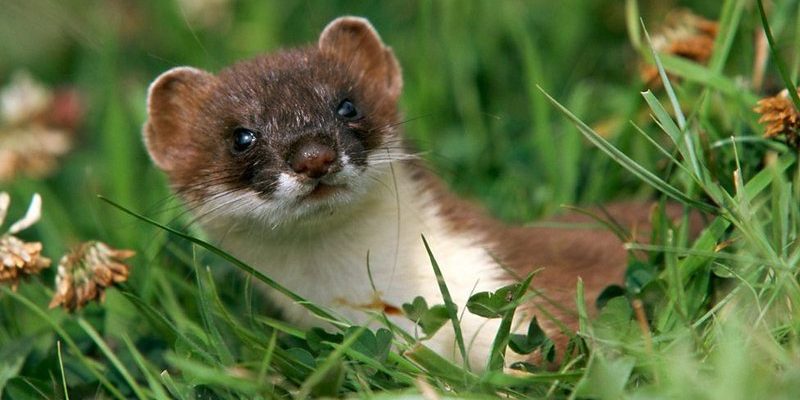
If you were to spot a stoat in the wild, you might first mistake it for a weasel. These clever little creatures are known for their agility and striking fur, which changes with the seasons. Stoats, with their sleek bodies and sharp features, are fascinating animals that play an important role in their ecosystems. You might be wondering what makes them so special, or how they live and thrive in the wild. Let’s dive into the world of stoats and uncover their secrets.
The stoat, also known scientifically as Mustela erminea, is a member of the mustelid family, which includes weasels, otters, and ferrets. Growing up to 30 inches long, they are agile hunters, known for their ability to dash through underbrush and even climb trees. But what truly sets them apart is their fur, which is a rich brown in summer and turns white during winter, with a distinctive black tip on the tail. This adaptation not only helps them blend into their surroundings but also allows them to remain stealthy while hunting.
Physical Characteristics
When it comes to appearance, stoats are truly unique. Their slender bodies are designed for speed, enabling them to twist and turn as they chase prey. Adult stoats weigh between 0.8 to 1.5 pounds and can reach a length of up to 30 inches, including their tail. Their fur is soft and dense, providing insulation against cold weather. During the winter months, their coat turns white, except for that striking black tail tip, making them look like little ghosts darting across the snowy landscape.
Another interesting feature of the stoat is its keen sense of hearing and eyesight. These adaptations are crucial for hunting, allowing them to detect even the slightest movements. Their long, slender limbs are perfectly built for quick sprints, making them proficient hunters. Stoats can run at speeds of up to 20 miles per hour, which is sprightly enough to catch unsuspecting prey. Imagine a tiny predator, racing through grass and underbrush, blending in with its surroundings — now that’s a sight to behold!
Habitat and Distribution
Stoats are adaptable creatures and can be found in a variety of habitats. From forests and grasslands to mountainous areas, these animals thrive in environments with plenty of cover. They are commonly found in Europe, Asia, and North America, which is quite impressive when you think about it. Stoats prefer areas where they can easily hide from predators and stalk their prey, and they often make their homes in burrows or under rocks.
These little hunters are not picky when it comes to their living space. Stoats can be found from sea level up to high mountain regions. In the summer, you’ll likely find them in more temperate areas, while in the winter months, they may venture to snow-covered regions, relying on their white fur for camouflage. This flexibility in habitat choice contributes to their survival and success as a species.
Diet and Hunting Behavior
Stoats are carnivorous, and their diet primarily consists of small mammals like voles, mice, and rabbits. They are skilled hunters, often employing a method called “stalking” where they quietly creep up on their prey. Once close enough, they’ll pounce with remarkable agility. What’s fascinating is that stoats have been observed hunting not just for food but also for fun. This playful behavior helps them hone their skills for when they truly need to hunt.
Their hunting strategy is not only about speed but also about their ability to adapt. Stoats can hunt alone, but they often use teamwork to take down larger prey. This social aspect is typically seen during breeding season when a male stoat is known to protect a nesting female and her young from threats. They are not only fierce hunters but also caring parents, showcasing a side of stoats that many people might overlook.
Reproduction and Lifespan
Stoats usually mate in late spring, and the female can give birth to a litter of between 4 to 6 kits around late summer. The kits are born blind and helpless, relying on their mother for nourishment and protection during the first few weeks of their lives. As they grow, they will start to explore their environment, learning the skills they need to survive. This nurturing phase is essential, as it sets the foundation for their future hunting abilities.
The average lifespan of a stoat in the wild is about 1 to 2 years, but some can live longer in favorable conditions, especially if they can avoid predators and health issues. In captivity, stoats can live up to 5 years. This short lifespan might sound daunting, but these little animals pack a lot of adventure into their years, chasing after prey and navigating their territories, making every moment count.
Behavior and Social Structure
Stoats are largely solitary animals, but they do have social interactions, especially during mating season. Their behavior can be quite captivating; they are known for their playful antics, which often include wrestling, chasing, and mock hunting. These playful behaviors may not only be for fun but also serve as practice for young stoats learning to hunt and develop their agility.
Interestingly, stoats can be territorial and may mark their territory with scents to ward off others. They are usually most active during dawn and dusk, taking advantage of low light conditions to hunt more effectively. So if you’re out in the early morning or late evening, keep an eye out for these lively little creatures zipping through the underbrush!
Threats and Conservation Status
Like many wild animals, stoats face various threats in their natural habitats. Their biggest threats include habitat loss due to human encroachment, as well as predation from larger birds of prey and domestic animals. Additionally, stoats can be misunderstood and may be viewed as pests, which leads to them being harmed by humans.
Despite these challenges, stoats are currently classified as a species of least concern, meaning they are not at immediate risk of extinction. However, conservation efforts to maintain their natural habitats and raise awareness about their role in the ecosystem are essential. Every creature, including the stoat, contributes to the balance of nature, and protecting them helps preserve our planet’s biodiversity.
Interesting Facts About Stoats
| Scientific Name: | Mustela erminea |
| Size: | Up to 30 inches long |
| Weight: | 0.8 to 1.5 pounds |
| Top Speed: | 20 mph |
| Lifespan: | 1 to 2 years (up to 5 in captivity) |
| Diet: | Small mammals, birds, and insects |
| Habitat: | Forests, grasslands, and mountainous regions |
Stoats in Culture and Folklore
Throughout history, stoats have been featured in various cultural stories and folklore. In some cultures, they are portrayed as clever tricksters, thanks to their agile movements and cunning hunting strategies. Their beautiful changing coats have also made them symbols of transformation and adaptability. In ancient societies, the stoat’s fur was often used in garments, especially in royal attire, symbolizing status and wealth.
In modern times, stoats continue to capture the imagination. They appear in children’s books, cartoons, and even as mascots, showcasing their playful nature. This representation helps raise awareness about wildlife and the importance of protecting these fascinating creatures. By sharing these stories, we can encourage a deeper appreciation for the natural world and all its inhabitants.
FAQ
What is the difference between a stoat and a weasel?
While stoats and weasels may look similar, there are key differences between them. Stoats are generally larger and have a more pronounced change in fur color with the seasons. They grow up to 30 inches long, whereas weasels typically reach about 10 inches. Additionally, stoats have a black tail tip, which is absent in many weasel species. This distinction helps in identifying them in the wild.
Can stoats be kept as pets?
Keeping stoats as pets is not common. They are wild animals with specific needs that are difficult to meet in a domestic setting. Their natural instincts and behaviors can make them challenging to care for. If you’re considering a pet, it’s usually better to choose domesticated animals that are bred to live alongside humans.
How do stoats communicate?
Stoats communicate using a combination of vocalizations and body language. They may growl, hiss, or make chattering sounds to convey messages, especially during courtship or when threatened. Additionally, they use scent marking to establish territory and communicate with other stoats. This multisensory approach to communication helps them navigate their environment effectively.
Are stoats endangered?
Stoats are currently classified as a species of least concern, meaning they are not at immediate risk of extinction. However, they do face threats from habitat loss and predation. Conservation efforts are important to maintain healthy populations and protect their natural habitats. Understanding their role in the ecosystem helps promote awareness and support for their conservation.
What do baby stoats look like?
Baby stoats, or kits, are born blind and have a soft, downy coat. They are small and helpless at birth but grow quickly. As they mature, their fur will begin to change in color, similar to adult stoats. Kits are usually weaned at about 6 weeks old and start to explore their surroundings, learning the skills needed to survive in the wild.
Do stoats hibernate?
No, stoats do not hibernate. Instead, they remain active throughout the winter months, hunting for food. Their winter coat provides insulation against the cold, allowing them to thrive in snowy conditions. Stoats have adapted to survive in various climates, making them resilient creatures in the face of seasonal changes.
What is the primary threat to stoats?
The primary threats to stoats include habitat loss due to urban development and agricultural practices. Additionally, they are vulnerable to predation by larger animals and can be misunderstood by humans, leading to persecution. Raising awareness about their role in the ecosystem is essential for their protection and conservation.
How fast can a stoat run?
Stoats are surprisingly fast for their size, capable of reaching speeds up to 20 miles per hour. This speed helps them catch prey and evade predators. Their agile bodies and quick reflexes make them adept hunters and survivors in the wild.
Do stoats have natural predators?
Yes, stoats have natural predators, including birds of prey like hawks and eagles, as well as larger mammals such as foxes and domestic pets. These predators play a role in the ecological balance, but stoats use their agility and camouflage to evade danger.
Can stoats swim?
Yes, stoats are capable swimmers! They can navigate through water when necessary, which is an excellent survival skill. This ability helps them hunt for prey near rivers and lakes and escape from potential threats when needed.
How can I help stoats?
There are several ways you can help stoats and other wildlife. Supporting local conservation efforts, avoiding the use of pesticides, and promoting habitat preservation are crucial steps. Educating others about the importance of stoats in ecosystems also helps foster a greater appreciation for these creatures. By being mindful of our environmental impact, we can all contribute to the protection of wildlife.

